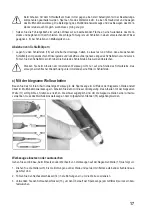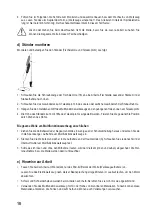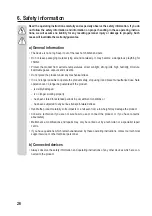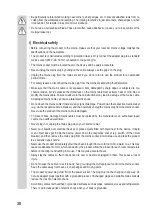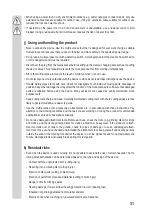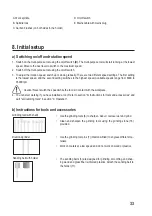
31
• When using a power tool in a dry environment outdoors, e.g. under canopies or under stands, only use
extension cables that are suitable for outdoor use. Using an extension cable suitable for outdoor use
reduces the risk of an electric shock.
• If operation of the power tool in a humid environment is unavoidable, use a residual current circuit
breaker. Using a residual current circuit breaker reduces the risk of an electric shock.
j) Using and handling the product
• Never overload the device. Use the multi-purpose tool that is designed for your work. Using a suitable
multi-purpose tool ensures that you can work better and more safely in the specified power range.
• Do not use a multi-purpose tool with a defective switch. A multi-purpose tool that cannot be switched on
or off is dangerous and must be repaired.
• Disconnect the plug from the mains socket before setting up the device, changing accessories or putting
the device away. This precaution prevents the multi-purpose tool from starting unintentionally.
• Store the multi-purpose tool out of the reach of children when it is not in use.
• Do not let anyone who is unfamiliar with the device or who has not read these instructions use the device.
• Handle multi-purpose tools with care. Check for misalignment or binding of moving parts, breakage of
parts and any other damage that may affect the function of the multi-purpose tool. Ensure that damaged
parts are repaired before using the device. Many accidents are caused by poorly maintained multi-
purpose tools.
• Keep cutting tools sharp and clean. Carefully maintained cutting tools with sharp cutting edges are less
likely to get jammed and are easier to guide.
• Use the multi-purpose tool, accessories, attachments etc. in accordance with these instructions. Pay
attention to the working conditions and the task you are working on. Using the product for unintended
applications can lead to hazardous situations.
• Do not use damaged attachment tools. Before each use, check the tools (e.g. grinding discs) for chips
and cracks, and check the grinding plates for cracks, abrasion or heavy wear. If the product or attach-
ment tool falls over or falls to the ground, check for signs of damage or use an undamaged attach-
ment tool. Once you have checked and installed the attachment tool, keep yourself and nearby persons
outside the area of the rotating tool and let the device run at the highest speed for approximately one
minute. Damaged tools will usually break during this test period.
k) Residual risks
• Even when the device is used correctly, it is not possible to exclude the risk of certain hazards. The fol-
lowing potential hazards can be determined based on the type and design of the device:
- Contact with the unprotected disc (cutting injury)
- Reaching into a rotating disc (cutting injury)
- Ejection of disc parts (cutting or blunt injury)
- Ejection of parts from processed material (cutting or blunt injury)
-
Danger of fire from flying sparks
- Hearing damage if no prescribed hearing protection is worn (hearing loss)
- Inhalation of grinding particles from material and disc
- Electric shock when touching non-insulated electrical components.

